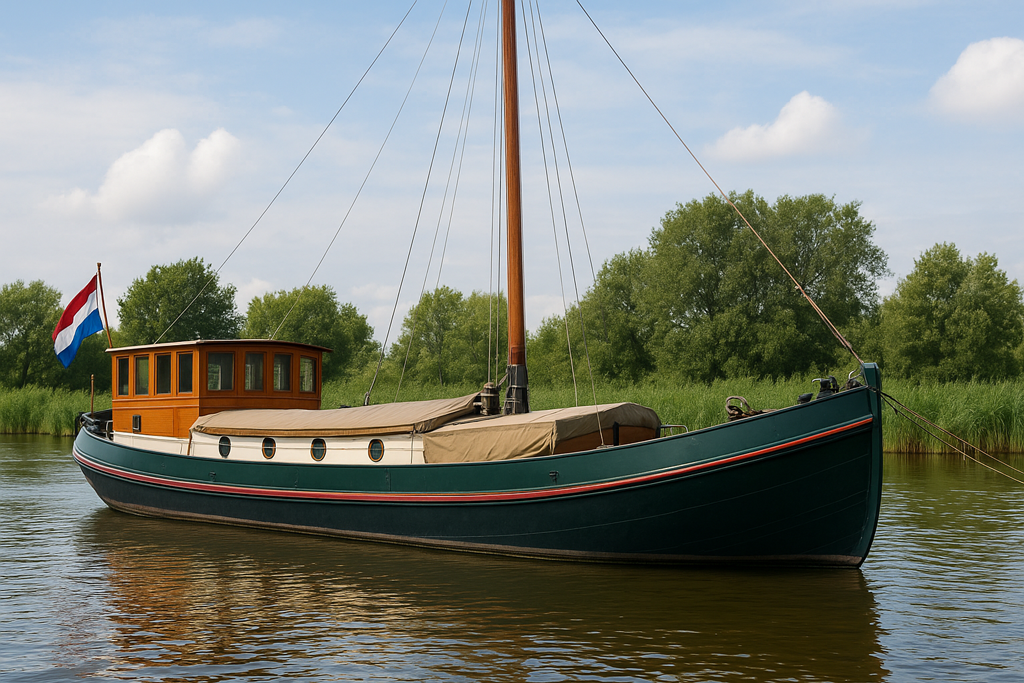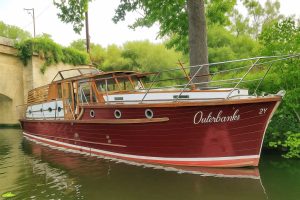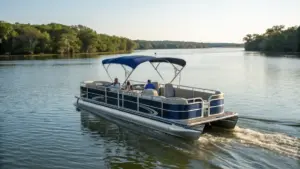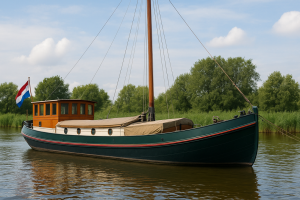The distinctive silhouette of a traditional Dutch barge has graced European waterways for centuries. These magnificent vessels, originally designed for commercial cargo transport across the Netherlands’ extensive canal network, have evolved into some of the most desirable floating homes available today. With their impressive beam, generous headroom, and unmistakable character, Dutch barges offer a unique combination of historical authenticity and modern luxury that appeals to discerning waterway enthusiasts throughout the UK.
The Unique Appeal of Dutch Barges
Dutch barges represent the aristocracy of inland waterway vessels. Their substantial construction and spacious accommodation dwarf even the largest narrowboats, creating floating homes that rival land-based properties for comfort and style.
The impressive dimensions of Dutch barges – typically 15-20 metres long and 4-5 metres wide – provide living space that simply cannot be achieved in traditional British canal boats. High ceilings, full-size windows, and expansive deck areas create an entirely different lifestyle experience from conventional narrowboat living.
Historical Significance and Authenticity
Traditional Dutch barges carry decades of maritime history in their steel hulls. Many vessels available in the UK market date from the early-to-mid 20th century, representing authentic working boats with genuine provenance and character.
Conversion quality varies dramatically, from basic amateur projects to professional transformations that preserve historical features while incorporating luxury amenities. The best conversions respect the vessel’s industrial heritage while creating comfortable modern homes.
Living Space Advantages
Generous proportions allow for full-height ceilings throughout, eliminating the stooped postures required in many narrowboats. Standard doorways, proper staircases, and room-sized compartments create genuinely comfortable living environments.
Outdoor spaces on Dutch barges excel, with vast aft decks perfect for entertaining and forward holds that can be converted into stunning garden areas or workshops.
Types of Dutch Barges in the UK Market
The Dutch barges available to UK buyers represent diverse origins and conversion approaches, each offering distinct advantages and challenges.
Traditional Working Barges
Luxemotor barges feature the classic spoon-shaped bow and represent the pinnacle of Dutch barge design. These vessels typically measure 20+ metres and offer the most impressive accommodation potential.
Tjalk barges display the characteristic rounded stern and shallow draught that allowed access to smaller waterways. Their distinctive appearance and practical design make them highly sought-after.
Modern Interpretations
New-build Dutch-style barges combine traditional aesthetics with contemporary construction techniques and systems. While lacking historical authenticity, they offer modern reliability and warranty protection.
Steel narrowboats with Dutch styling elements provide a compromise between traditional barge accommodation and UK waterway accessibility.
Where to Source Quality Dutch Barges
Finding the right Dutch barge requires understanding the specialist market and dealers who focus on these distinctive vessels.
Established Barge Specialists
Peters & May offers comprehensive services for importing and converting Dutch barges, with extensive experience in both traditional and modern vessels.
Barge Broker specialises exclusively in Dutch barges and provides detailed knowledge of individual vessels’ histories and conversion potential.
Continental Waterways focuses on Continental vessels and offers valuable insights into the European Dutch barges market.
Continental Sources
Dutch dealers like Yachtcharter 2000 and Jachtmakelaar Zuidwest offer direct access to the Netherlands market, though importation requires careful planning.
Belgian brokers frequently list interesting vessels, particularly working barges from the industrial waterways around Antwerp and Brussels.
UK-Based Options
Thames-based dealers often stock imported Dutch barges already converted for UK use, eliminating importation complexities.
Private sellers advertise through specialist publications like Waterways World and online platforms, though buyer beware principles apply strongly.
Critical Buying Considerations
Dutch barges present unique challenges that differ significantly from traditional narrowboat purchases. The combination of age, size, and complex systems requires careful evaluation.
Structural Assessment
Hull thickness on working barges varies considerably depending on age and maintenance history. Professional ultrasonic testing can reveal dangerous corrosion before purchase.
Conversion structural integrity requires expert assessment, particularly where bulkheads have been removed or modified. Some conversions compromise the vessel’s structural strength.
Welding quality varies dramatically between professional shipyards and amateur work. Poor welding can create expensive repair bills and potential safety hazards.
Systems and Equipment
Electrical installations on converted barges often combine 12V boat systems with 240V domestic installations. Ensure proper integration and safety certification.
Heating systems must cope with large volumes and steel construction. Undersized systems create condensation problems and uncomfortable living conditions.
Water and waste systems require careful design in the generous spaces available. Poor installations can create expensive remediation requirements.
Major Pitfalls to Avoid
The Dutch barges market contains numerous traps for unwary buyers, many stemming from the vessels’ commercial origins and conversion complexities.
Structural Nightmares
Hidden corrosion can affect working barges that spent decades carrying abrasive or corrosive cargoes. Cargo holds may show extensive damage not immediately visible.
Conversion shortcuts create ongoing problems and potential safety hazards. Amateur electrical work, inadequate insulation, and poor ventilation plague many converted vessels.
Modification damage from insensitive conversions can destroy both structural integrity and historical value. Check for proper engineering approval of major modifications.
Legal and Regulatory Issues
Import documentation problems can create serious legal complications. Ensure proper VAT treatment and registration before purchase.
Survey requirements differ from narrowboats due to size and complexity. Standard narrowboat surveyors may lack expertise in commercial vessel construction.
Mooring restrictions significantly limit where Dutch barges can berth. Many UK marinas cannot accommodate vessels over 60 feet, and few can handle the beam of large barges.
Ongoing Cost Surprises
Maintenance expenses on Dutch barges typically exceed narrowboat costs due to size, complexity, and specialist requirements. Budget accordingly for annual expenses.
Mooring fees reflect the substantial space requirements, often doubling or tripling narrowboat costs.
Insurance premiums vary widely based on conversion quality, value, and cruising area. Some insurers avoid Dutch barges entirely.
Making Your Dutch Barge Investment
Dutch barges offer unparalleled living space and character but demand realistic assessment of costs, limitations, and maintenance requirements.
Consider your long-term cruising plans carefully. These substantial vessels suit settled cruising patterns rather than constant movement, and mooring options remain limited compared to narrowboats.
The UK’s Dutch barges community provides valuable support and expertise, but success depends on choosing the right vessel for your circumstances and budget. With proper selection and maintenance, a Dutch barge provides a unique lifestyle that combines the romance of maritime history with the comfort of a genuinely spacious floating home.
Featured image: AI generated.




